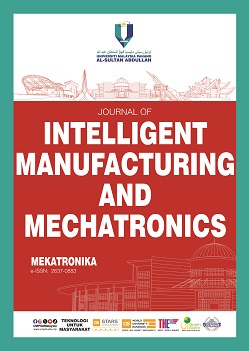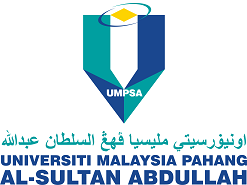Developing a Sustainability Assessment Model for Coolant Impacts on Surface Quality in Ball End Milling
DOI:
https://doi.org/10.15282/mekatronika.v7i1.11840Keywords:
Sustainable machining, Coolant performance, Surface roughness, Regression analysisAbstract
Cutting fluids play a critical role in machining operations, yet excessive or inefficient use poses environmental challenges and affects workers' health, highlighting the need for optimised and sustainable practices. This study addresses the challenge of balancing machining performance and sustainability by experimentally investigating ball end milling of AISI 1040 steel using uncoated HSS tools under dry, mist, 4% coolant, and 8% coolant conditions with constant cutting parameters. Machining performance was evaluated based on surface roughness, with mist coolant in down milling achieving the best results (average roughness of 0.462 μm), followed by mist coolant in up milling, 8% coolant, and 4% coolant in up milling. The research highlights the significant impact of coolant conditions on machining performance and surface quality while integrating sustainability principles. A regression-based model was developed to predict interactions between sustainability parameters and machining attributes, offering insights to optimise processes with environmental and societal considerations, thereby supporting sustainable manufacturing practices.
References
[1] Y. Altintas, Manufacturing Automation: Metal Cutting Mechanics, Machine Tool Vibrations, and CNC Design (2nd ed.), New York: Cambridge University Press, 2012.
[2] J. P. Davim, Modern Manufacturing Engineering (1st ed.), Springer, 2021.
[3] K. K. Gajrani, M. R. Sankar, “Role of eco-friendly cutting fluids and cooling techniques in machining,” In Materials Forming, Machining and Post Processing, pp. 159-181, 2020.
[4] D. J. Hiran Gabriel, M. Parthiban, I. Kantharaj, N. Beemkumar, “A review on sustainable alternatives for conventional cutting fluid applications for improved machinability,” Machining Science and Technology, vol. 27, no. 2, pp. 157–207, 2023.
[5] F. Pusavec, P. Krajnik, J. Kopac, “Transitioning to sustainable production – Part I: Application on machining technologies,” Journal of Cleaner Production, 18(2), 174–184, 2010.
[6] K. K. Gajrani, A. Prasad, A. Kumar, Advances in Sustainable Machining and Manufacturing Processes (1st ed.), CRC Press, 2022.
[7] P. Kumar, A. K. Jain, P. K. Chaurasiya, D. Tiwari, A. Gopalan, J. Arockia Dhanraj, et al., “Sustainable machining using eco-friendly cutting fluids: A review,” Advances in Materials Science and Engineering, vol. 2022, no. 2, p. 5284471, 2022.
[8] M. K. Gupta, M. Jamil, X. Wang, Q. Song, Z. Liu, M. Mia, et al., “Performance evaluation of vegetable oil-based nano-cutting fluids in environmentally friendly machining of inconel-800 alloy,” Materials, vol. 12, no. 17, p. 2792, 2019.
[9] G. Gaurav, A. Sharma, G. S. Dangayach, M. L. Meena, “A review of minimum quantity lubrication (MQL) based on bibliometry,” Current Materials Science, vol. 14, no. 1, pp. 13–39, 2021.
[10] L. Wang, W. Cai, Y. He, T. Peng, J. Xie, L. Hu, et al., “Equipment-process-strategy integration for sustainable machining: A review,” Frontiers of Mechanical Engineering, vol. 18, no. 3, p. 36, 2023.
[11] R. Fernando, J. Gamage, H. Karunathilake, “Sustainable machining: Environmental performance analysis of turning,” International Journal of Sustainable Engineering, vol. 15, no. 1, pp. 15–34, 2022.
[12] R. Bertolini, S. Bruschi, A. Ghiotti, E. Savio, L. Ceseracciu, I. S. Jawahir, “Surface integrity and superelastic response of additively manufactured Nitinol after heat treatment and finish machining,” CIRP Annals, vol. 72, no. 1, pp. 501–504, 2023.
[13] M. Soori, B. Arezoo, “The effects of coolant on the cutting temperature, surface roughness and tool wear in turning operations of Ti6Al4V alloy,” Mechanics Based Design of Structures and Machines, vol. 52, pp. 3277–3299, 2024.
[14] T. Rajmohan, V. V. K. Chakravarthy, A. Nandakumar, S. D. S. Kumar, “Eco friendly machining processes for sustainability – Review,” IOP Conference Series: Materials Science and Engineering, vol. 954, p. 012044, 2020.
[15] S. N. Selamat, N. H. M. Nor, M. H. A. Rashid, M. F. Ahmad, F. Mohamad, A. E. Ismail, et al., “Review of CO2 reduction technologies using mineral carbonation of iron and steel making slag in Malaysia,” Journal of Physics: Conference Series, vol. 914, p. 012012, 2017.
[16] N. H. A. Halim, C. H. C. Haron, J. A. Ghani, M. F. Azhar, “Tool wear and chip morphology in high-speed milling of hardened Inconel 718 under dry and cryogenic CO2 conditions,” Wear, vol. 426, pp. 1683–1690, 2019.
[17] O Pereira, A Celaya, G Urbikaín, A Rodríguez, A. Fernández-Valdivielso, L. Noberto López de Lacalle, “CO2 cryogenic milling of Inconel 718: cutting forces and tool wear,” Journal of Materials Research and Technology, vol. 9, no. 4, pp. 8459–8468, 2020.
[18] N. R. Dhar, M. Kamruzzaman, M. Ahmed, “Effect of minimum quantity lubrication (MQL) on tool wear and surface roughness in turning AISI-4340 steel,” Journal of Materials Processing Technology, vol. 172, pp. 299–304, 2006.
[19] M. K. Gupta, P. Niesłony, M. Sarikaya, M. E. Korkmaz, M. Kuntoğlu, G. M. Królczyk, “Studies on geometrical features of tool wear and other important machining characteristics in sustainable turning of aluminium alloys,” International Journal of Precision Engineering and Manufacturing-Green Technology, vol. 10, pp. 943–957, 2023.
[20] X. Wang, C. Li, Y. Zhang, W. Ding, M. Yang, T. Gao, “Vegetable oil-based nanofluid minimum quantity lubrication turning: Academic review and perspectives,” Journal of Manufacturing Processes, vol. 59, pp. 76–97, 2020.
[21] F. M. Turan, K. Johan, “Assessing sustainability framework of automotive related industry in the Malaysia context based on GPM P5 standard,” ARPN Journal of Engineering and Applied Sciences, vol. 11, pp. 7606–7611, 2016.
[22] N. S. Sahimi, F. M. Turan, K. Johan, “Development of sustainability assessment framework in hydropower sector,” IOP Conference Series: Materials Science and Engineering, vol. 226, p. 012048, 2017.
[23] F. M. Turan, K. Johan, N. H. M. Nor, “Criteria assessment model for sustainable product development,” In IOP Conference Series: Materials Science and Engineering, vol. 160, p. 0124, 2016.
[24] W. N. S. W Lanang, F. M. Turan, K. Johan, “Systematic assessment through mathematical model for sustainability reporting in Malaysia context,” In IOP Conference Series: Materials Science and Engineering, vol. 226, p. 012049, 2017.
[25] F. M. Turan, K. Johan, W. N. S. W. Lanang, N. H. M. Nor, “Development of systematic sustainability assessment (SSA) for the Malaysian industry,” In IOP Conference Series: Materials Science and Engineering, vol. 160, p. 012047, 2016.
[26] N. S. Sahimi, F. M. Turan, K. Johan, “Framework of Sustainability Assessment (FSA) method for manufacturing industry in Malaysia,” In IOP Conference Series: Materials Science and Engineering, vol. 342, p. 012079, 2018.
[27] K. Salonitis, P. Stavropoulos, “On the integration of the CAx systems towards sustainable production,” Procedia CIRP, vol. 9, pp. 115–120, 2013.
[28] K. Bunse, M. Vodicka, P. Schönsleben, M. Brülhart, FO Ernst, “Integrating energy efficiency performance in production management – gap analysis between industrial needs and scientific literature,” Journal of Cleaner Production, vol. 19, pp. 667–679, 2011.
[29] A. Davé, K. Salonitis, P. Ball, M. Adams, D. Morgan, “Factory eco-efficiency modelling: Framework application and analysis. Procedia CIRP, vol. 40, pp. 214–219, 2016.
[30] A. Davé, P. Ball, K. Salonitis, “Factory eco-efficiency modelling: Data granularity and performance indicators,” Procedia Manufacturing, vol. 8, pp. 479–486, 2017.
[31] P. Saxena, P. Stavropoulos, J. Kechagias, K. Salonitis, “Sustainability assessment for manufacturing operations,” Energies (Basel), vol. 13, p. 2730, 2020.
[32] J. A. Schey, Introduction to Manufacturing Processes (3rd ed.), McGraw-Hill, 2000.
[33] S. Krar, A. Gill, P. Smid, R. J. Gerritsen and J. Gill, Technology of Machine Tools (9th ed.), McGraw Hill, 2024.
[34] D. O. Aikhuele, F. M. Turan, S. M. Odofin, R. H. Ansah, “Interval-valued intuitionistic fuzzy TOPSIS-based model for troubleshooting marine diesel engine auxiliary system,” Transactions of the Royal Institution of Naval Architects Part A: International Journal of Maritime Engineering, vol. 159, p. A1, 2017.
[35] D. Aikhuele, F. M. Turan, “An intuitionistic fuzzy multi-criteria decision-making method based on an exponential-related function,” International Journal of Fuzzy System Applications, vol. 6, pp. 33–46, 2017.
[36] D. Aikhuele, F. M. Turan, “A hybrid fuzzy model for lean product development performance measurement,” In IOP Conference Series: Materials Science and Engineering, vol. 114, p. 012048, 2016.
[37] D. Aikhuele, F. M. Turan, “A modified exponential score function for troubleshooting an improved locally made offshore patrol boat engine,” Journal of Marine Engineering and Technology, vol. 17, no. 1, pp. 52-58, 2018.
[38] D. Aikhuele, F. M. Turan, “Proposal for a conceptual model for evaluating lean product development performance: A study of LPD enablers in manufacturing companies,” In IOP Conference Series: Materials Science and Engineering, vol. 114, p. 012047, 2016.
Downloads
Published
Issue
Section
License
Copyright (c) 2025 The Author(s)

This work is licensed under a Creative Commons Attribution-NonCommercial 4.0 International License.




